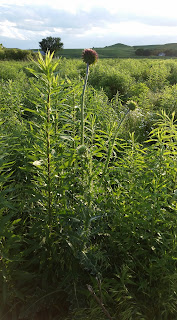There are lots of contradictions in prairie restoration, and killing the thistles butterflies are feeding on is one of them.
We should be doing everything we can to help pollinators survive.
We should be doing everything we can to eliminate Musk Thistle, a non-native Noxious Weed.
There's a contradiction here!
I am not a purist about non-native plants. If they co-exist harmoniously with our native plants, they may actually contribute to biodiversity. But if they are aggressively invasive, like Musk Thistle, Crown Vetch, Poison Hemlock, & Old World Bluestems, replacing native plants with monocultures of themselves, then they threaten the health of the whole. If they reduce biodiversity, I do what I can to remove them.
My hope is that fostering prairie plants will ultimately benefit all the creatures that depend on them, including pollinators. Butterflies will love it when the native Tall Thistles, present in our Creek Field in great abundance, start to bloom later in the summer.
But the Musk Thistles are blooming now. The Tall Thistles aren't.
It feels strange to remove the very plants butterflies at that moment are fluttering around!
Prairie ecologist Chris Helzer felt the same dilemma as he was killing off Musk Thistle from a Platte River prairie--except he was finding the prairie-dependent Regal Fritillary on Musk Thistle, not the more common Great Spangled Fritillary, which I show here.
He made the same choice I did: Remove the Musk Thistle; create a healthy plant community first. But as he put it,
"We ended up killing a lot of thistles out from under butterflies."
A contradiction like that sticks in your mind, provoking thought, planting a seed, perhaps allowing a blossom to open where beautiful, fluttery wisdom we don't yet have can ultimately land!








